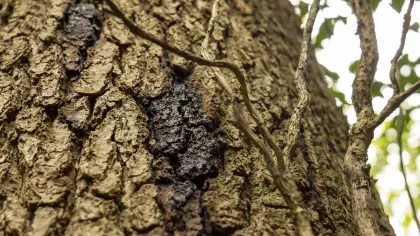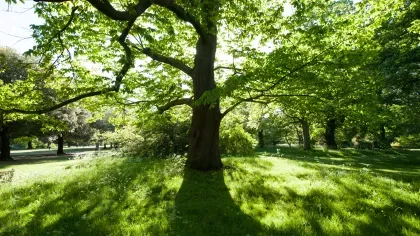19 June 2023
Putting in the hard graft
The secrets and quirks behind the technique that makes plants greater than the sum of their parts.

When you’re picking a plant, it’s all about finding the right set of characteristics.
Strong roots, sturdy trunk, bountiful buds and plentiful fruits: all key if you’re planting an orchard.
Similarly, when you’re picking a new ornamental, you want to make sure that it will quickly grow to its full beauty.
But it’s so hard to find a plant that successfully ticks all these boxes. In some cases, it’s possible to breed hybrids, but this can take years, if it’s successful at all.
That’s where grafting comes in: a way to combine the most desirable traits from two plants by fusing them together.
So how exactly does this plant take on Frankenstein’s monster work?

Building a better plant
To graft together two plants, you need a rootstock and a scion.
The rootstock is the root system and trunk or stem of a plant. The scion is formed of the upper stem, leaves, flowers and fruits.
Next, you have to bring the two together. There are various different techniques that are used, but it all relies on fusing the cambium layer of the scion with that of the rootstock.
The cambium layer is made up of the cells between the bark and the wood of the tree. Bringing these together in the graft allows the xylem and phloem (the tissues that carry the water, nutrients and sugars around the plant) to connect, keeping both parts alive and well.
To encourage the graft to take hold, the two parts can be secured together using tape or twine, and are sometimes covered in a special type of wax, to prevent water loss and infection.
If successful, the two plants will grow together, fusing into one more desirable specimen.


Best of both worlds
What are the benefits of bringing two plants together like this in the first place?
There’s a number of reasons, depending on what you want the plants for. In fruiting plants, grafting is a great way to keep things under control.
Scions from fruiting trees like apples, cherries and pears are often grafted to ‘dwarf’ rootstocks from naturally smaller trees. The resulting plant will be much smaller, taking up less room in an orchard, as well as being easier to harvest.
Additional benefits include a tree that produces fruit faster, as well as more resistance to frost and disease.
With ornamental plants, getting specific cultivars to grow from seeds can be difficult, and they often grow weakly on their natural roots systems. Grafting an already strong cultivar specimen onto a stronger rootstock allows for a more aesthetically pleasing plant to be sold.
Many popular ornamental plants, like wisteria or acers, are grafted in order to ensure a healthy specimen that blooms while still young.


Freaks of nature
But as with all horticultural techniques, sometimes grafting can have unforeseen consequences.
In a successful graft, the rootstock grows down into the ground, while the scion grows the flowers and fruit.
But in rare cases, the rootstock can continue to grow through the scion, and create what is known as a graft-chimaera. This is a single plant that’s formed of two separate species, with no crossbreeding.
An example of this is broom laburnum (+ Laburnocytisus 'Adamii'), a graft chimaera formed of two members of the pea family, Fabaceae.
Unsurprisingly, this chimaera is the result of the grafting of a broom scion to a laburnum stock. First recorded in Paris in 1825, the laburnum grows inside the broom, and produces an incredibly unique plant.
Most of the tree's branches have laburnum leaves but will also have groups of dark green broom-like shoots. The flowers also vary, with some branches having long strands of yellow laburnum flowers, and others, clusters of purple broom flowers.
Incredibly, some branches display flowers that are a dark yellow-pink – a mix between both broom and laburnum.

Fruity favourites
Another well-known graft chimaera is the aptly named bizzaria (Citrus medica + C. aurantium), which produces three types of fruit: Florentine citron, sour orange, and a fusion of the two.
In the UK, another graft chimaera goes by the name ‘strawberries and cream’ tree.
Found in Backwell, Somerset, this tree is a graft-chimaera between two species: the wild cherry (Prunus avium) and a variety of Japanese cherry (Prunus serrulata) called ‘kanzan’.
Grafted ornamental cherry trees are a common site across the UK, but the chimaera in Backwell stands out for displaying both pink and white flowers on the same tree.
Since graft chimaeras are rare, grafting remains a powerful horticultural technique, whether building a better fruit tree, or producing the perfect ornamental plant.






